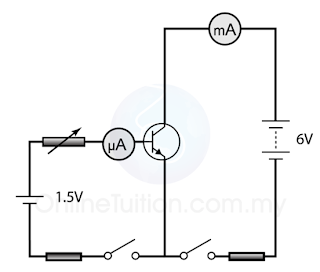Transistor as an Amplifier
- The major application of a transistor is as a current amplifier.
- A transistor can be used to amplify (‘magnify’) current changes because a small change in base current produces a large change in collector current.
- A simple transistor amplifier circuit is shown in Figure 1 below.
 |
| (Figure 1) |
- The graph in Figure 2 below shows the relationship between the base current and the collector current. From the graph, we can conclude that the collector current is directly proportional to the base current.
 |
| (Figure 2: The collector current is directly proportional to the emitter current) |
- Since the small change in the base current IB results in a big change in the collector current, IC, the transistor, therefore, function as a current amplifier.
- The ratio IC/IB is called the amplification factor.
- Figure 3 below shows another amplification circuit. In this case, however, the base current is varying because of the small alternating voltage produced by the microphone.
 |
| (Figure 3) |
- The small changes in base current cause much larger changes in collector current.
- The collector circuit includes an earphone through which you would hear an amplified version of the original sound.
- The input capacitor passes on current changes from the microphone but blocks the steady current which might otherwise flow through the microphone from the potential divider. Such a current would upset the biasing effect of the potential divider.
